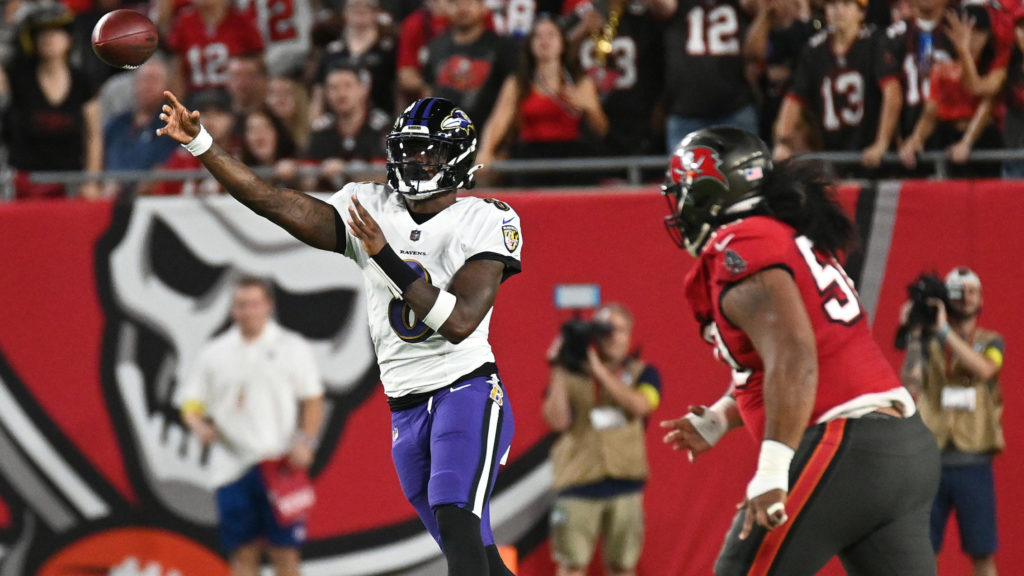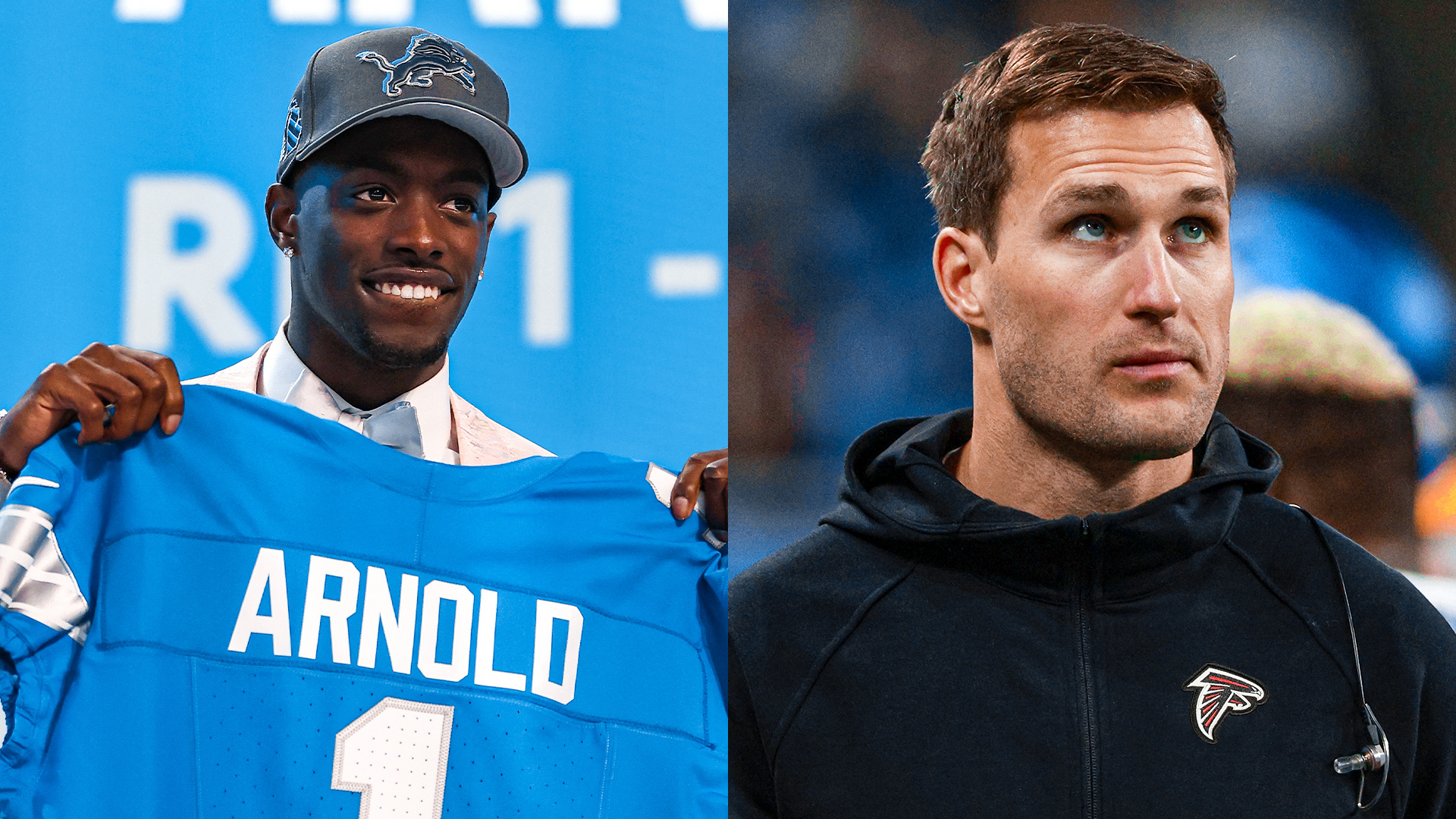Analysis
11/9/22
13 min read
Sports Info Solutions: Explaining How Total Points Can Better Evaluate NFL Talent

On this site, you’ll see Total Points referred to a lot. It’s SIS’s answer to the question, “how many points on the scoreboard was this player worth, based on his play-to-play contributions?”
This article is here to give you a rundown of what Total Points is at its core, how it’s built and how it changes the way we think about player value.
What do Total Points do?
Total Points takes nearly everything SIS measures about a play and uses it to evaluate each player on a scale allowing you to easily compare them.
It's always useful to understand the different ways in which players can be valuable. Does he break a lot of tackles? Will he get a lot of yards after the catch? Does he make the best out of a poor offensive line? Total Points offers the opportunity to take all of those elements and get a quick picture of how well a player is performing overall.
What Does the Number Mean?
All of Total Points use the Expected Points Added (EPA) framework, so let’s take a second to walk through that.
EPA unsurprisingly comes from Expected Points. Expected Points is basically the average number of points you’d expect to score from a given field position, down and distance.
For example, a first down inside the red zone might have an Expected Points of four, meaning the offensive team should be expected to score four points on average from that spot. A third down from your own 15-yard line might have a negative Expected Points, meaning you’d actually expect the opponent to score first.
EPA is just the play-to-play change in Expected Points. So, if you convert that third down from your own 15 (where your Expected Points before the play was -1) and the next play’s down, distance and field position has an Expected Points of one, then that play had an EPA of +2.
Roughly, you can think of a zero EPA play as one that "stays on schedule", an EPA of one or more as a big play for the offense (we call these “Boom” plays), and an EPA of negative-one or less as a big play for the defense (we call these “Bust” plays).
Total Points starts by evaluating each player on that scale, where zero is average. That's what we call Points Above Average. Then to both reward players who play full seasons and keep the sum of Total Points around what we'd expect a team to score or allow, we scale the results to the league scoring average (around 22 points per game). So a quarterback with 170 Total Points for a season is roughly contributing 10 points per game to his team’s total.
On the defensive side, it's a little bit harder to wrap your mind around because the scaling is exactly the same but points are bad for the defense. A cornerback with 50 Total Points can be thought of as having reduced the opponent’s scoring potential by 50 points during the course of the season.
What Do We Do With It?
Overall, we use it as a measure of how valuable a player was. Most of the leaders in Total Points will line up with who people would agree were the best players in a given season.
But beyond that, it’s helpful to find players whose traditional stats or reputation don't line up with their production.
Raiders QB Derek Carr has had strong Total Points showings in the past because he’s been effective on money downs. On the flip side, Ravens QB Lamar Jackson has lost some value because of his tendency to fumble (even without losing possession).
Rushers that break tackles and make the best of bad blocking will stand out, while a year of four yards and a cloud of dust runs will look way below average.
We can more directly compare a shutdown corner, who is a solid tackler to one who’s flashed with interceptions and touchdowns.
Total Points gives us the opportunity to more critically engage with the stats players compile and consider the context in which they compiled them. And as SIS continues to add more data points to its operation, our assessment of those things will only get better.
How Does it Work?
We won't go into complete detail here, but let's run down the different data elements we consider, how they are evaluated in terms of EPA and how they get bundled together. If you aren’t interested in this level of detail, The Gist will give you a sense of things.
The Gist
Let's say that you read all this stuff and already kind of forget what you read at the beginning. Here's a quick-and-dirty version:
- We take Expected Points Added and give individual value to every player on every scrimmage play, starting in 2016
- You can find Total Points in various locations on this site, both as a player stat and as a team stat.
- Pass Offense: Quarterbacks and receivers split value for the throw, the catch, after-catch yards and after-contact yards. Additional considerations for offensive line performance, uncatchable passes and drops.
- Pass Defense: Defensive backs are measured on how often they are targeted above expectation, and much of the value the receivers or QB get on completion is correspondingly taken away from the defender. Pass rushers are credited for forcing blown blocks and disruptions at the point of attack.
- Rush Offense: The offensive line and running back both take responsibility for yards before contact (weighted towards the O-line), while yards after contact beyond what's expected are totally owned by the back. Broken tackles hold a lot of value.
- Rush Defense: Preventing yards before contact is the name of the game for the defensive line, while linebackers and defensive backs get value from making tackles that limit yardage compared to expectation and not missing out on easy tackle opportunities.
- In general, there's a lot of value to be gained and lost from turnovers (or turnover-worthy plays) and plays in key spots (e.g. just outside field goal range, third down).
Detailed Explanation
Total Points works on the passing game and running game as a whole, so we'll walk through them that way.
Pass Plays
Blocking
Everything starts up front. We start with identifying who was rushing the passer and who was blocking. Then, we estimate how likely each person was to either blow a block (offense) or force a blown block (defense). On each play, credit is assigned to each player based on how they performed compared to that expectation, and the resulting blown block plus-minus value is multiplied by the average EPA of a blown block.
Players are additionally credited or debited if they were involved for good or for bad in a batted pass, deflection, or pressure, based on the average EPA of those events. This is one of the payoffs of watching film of every play.
Almost everything SIS charts on a play — like batted passes, deflections and pressures — contributes credits or debits to a player's ledger. In these cases, the value corresponds to the average EPA impact when one of those things happens.
Pass Attempts
Each pass attempt gets split into four portions: the throw, the catch, yards after the catch before contact and yards after contact.
For any throw, we take the value of the route at the intended depth in terms of its completion rate and interception rate and give the quarterback a big chunk of that value.
A similar basis is used to estimate how much of the two YAC components we expect, and we give the receiver credit based on the difference in EPA between what he achieved and what was expected.
The receiver and quarterback split the value of the throw, air yards, and yards after the catch before contact, while the receiver gets the after-contact value on his own. Beyond that, we ensure off-target throws don't hurt the receiver and drops don't hurt the quarterback.
The defense at large takes responsibility for the throw itself because many factors contribute to the throw that's selected, but the primary defender in coverage is responsible for the catch and yards after the catch. Any broken or missed tackles are evaluated according to the EPA impact of one of those on average.
If the pass is intercepted, the quarterback and defender are equally debited and credited points based on where the ball was caught. The defender then gets extra credit for the change in field position from his return.
All players running routes or defending in coverage have an expected target rate based on the coverage scheme, number of routes being run, route type, and alignment. Each player is assigned a value according to how many targets above expectation they had, scaled according to the EPA value of the potential target.
Pressure, Sacks and Fumbles
Quarterbacks are given full responsibility for the sacks they incur (less the value of any blown blocks by the offensive line). They are given neither credit nor blame for pressure unrelated to blown blocks, with the idea that their throws are made more difficult but they also had some part in the pressure in the first place.
Sacks or evaded sacks are measured using the EPA of the sack (or potential sack). The sacker(s) get full credit unless it was deemed a coverage sack, in which case the coverage unit splits the credit.
Pass rushers are given credit for how well they generate pressure relative to the average of players lined up at the same position. Any pressure-related events that might have been debited from the line are given back to the receivers (and quarterback in the case of blown blocks), owing to their having a harder job as a result of the pressure.
All fumbles, recovered or lost, are evaluated similarly. The value of the potential turnover from that spot on the field is multiplied by the odds that possession will be lost based on whether it was in the backfield or not.
So players who fumble a lot are docked a lot of value, even if the offense recovered most of them. The person who recovers the fumble gets the inverse of the value that would be lost if the offense recovers, or the "rest" of the fumble value if the defense recovers (i.e. the value of the turnover multiplied by the odds that it is recovered).
Run Plays
Blocking
Like with passing, the first step is to identify the blockers and box defenders. In addition, we use the intended and eventual run direction to identify the key blockers and defenders on the play (based on data elements like defensive techniques).
From there, we calculate the play's expected yards before and after contact based on the number of box defenders, the blocking scheme, the run direction, the spot on the field, etc.
The blockers are evaluated based on the play's performance above that expectation, with most of the credit or blame goes to the key blockers identified earlier (unless the runner cut the run back or bounced outside, in which case we re-allocate based on where the run ended up).
The credit that is given to the offensive line for the early yards on the play shifts depending on when the rusher is contacted. That ranges from taking on 90% of the responsibility for plays that are blown up to 25% of the yards before contact beyond the first fifteen.
The same value is distributed among the box defenders, again focusing on the defenders at the intended gap. Blown blocks are evaluated similarly to what's done in the passing game.
On plays where the back bounces or cuts the run back, the linemen initially run behind are evaluated differently from those who the back eventually runs behind. The extent of the difference depends on the direction and magnitude of the back's movement. For example, cutbacks of 3 or more gaps are the most valuable bounce or cutback, so the value lost by the initial linemen is small because the cost of the cutback is small.
Rushing
The runner is evaluated against the offensive line's expected performance calculated above. The rusher is given some credit for yards before contact because elusive runners can generate their own space, but most of his value will come after contact. The back's responsibility for yards before contact increases the more yards he gains before contact, as it's more likely he had a role in that result.
On any play where a broken tackle was charted, we ignore the yards after contact portion and instead give the back a standard EPA amount based on the average value of a broken tackle. Fumbles are treated like they are on pass plays.
Tackling
Given each defender's initial alignment, the heaviness of the box, and the run direction, we estimate the probability that each player would make the tackle and the EPA that would be expected if each of the possible defenders made the tackle.
A plus-minus system is used to combine the expected tackle rate and tackle value for each player and measure that against whether the player actually recorded a tackle.
This might be worth an example.
Say a player has a 10% chance of making a tackle that is worth +0.5 EPA if he makes it.
He’d get (1 - 0.1) x 0.5 = +0.45 points’ worth of credit if he makes the tackle, and (0 - 0.1) x 0.5 = -0.05 points’ worth of debit if he doesn’t.
That system is also modified to ensure that making a tackle is always better than not making one, regardless of the value of said tackle compared to expectation.
Broken or missed tackles are taken independent of where they are on the field, so each one is considered worth the value of an average broken or missed tackle in terms of EPA.
Additional Adjustments
Play Selection
At this point, it's common knowledge run plays are less valuable on average than pass plays. We can see this because the average yards per attempt on passes is much higher than it is on runs. At a more granular level, coaches can make inefficient decisions by electing to, for example, run from heavy personnel on second-and-10 while trailing.
In order to more accurately evaluate the players on a play as opposed to the coaches or situations, we implemented a Play Selection Adjustment, which applies to each player on each play.
We take the expected value of the play given the run/pass decision and some personnel and game state information, compare it to an average play, take the difference, and distribute that value among the players involved. That way, a back being run into a heavy box time and again isn't punished simply for being on the field in a sub-par situation for him.
This adjustment generally moves a player a handful of points one way or the other depending on how often he was involved in pass or run plays.
Season Scoring
As mentioned above, after all of the initial calculations are done, we rescale everything so that the league total is in line with the league's scoring average, or just over 22 points per team per game. Because the quarterback represents the most obviously critical position, he's given 1/3 of this adjustment for the offense, and the rest is split among the other offensive players.
Prepared by Alex Vigderman







